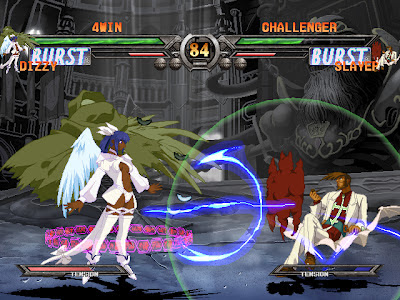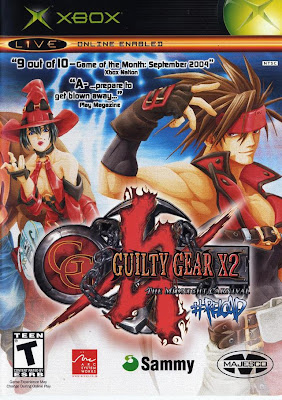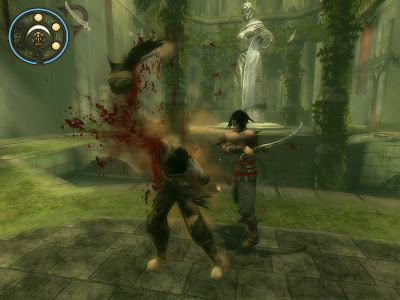The Short
Pros
- The absolute best version of the X/XX iterations of Guilty Gear (it would be changed in Slash following)
- Insane roster of 22 characters plus 2 unlockable ones
- Improved controls make Dust attacks as well as specials easier to pull off
- Visuals look incredible
- Game has a massive amount of content, including a survival mode, challenge missions, story modes for each character, and more
- Combos and ariels are still fun and make the game quite accessible
- Thankfully it's one of the many backwards compatible games for Xbox 360.
Cons
- Movesets, while extremely similar, are a bit more tricky than in the original Guilty Gear X
- Online play, which was the main improvement of #Reload over the PS2 version, is gone since Microsoft cut orignal Xbox Live servers
- No widescreen support hurts
- Voices, while thankfully in the original Japanese, seem much more chatty and obnoxious than previous installments
- Xbox controller sucks at fighting games. Mostly because that d-pad is absolute garbage, especially on the 360.
- Still is, at its core, the same game as Guilty Gear X
 |
| Heaven or Hell: Let's Rock! Again! |
The Long
First off, let me point out the actual full title of this game (according to the box) is Guilty Gear X2: The Midnight Carnival #Reload. Ho-ly piss. Great name, guys. No, seriously, good work on that. Rolls right off the tongue.
Anyway, stupid name aside, Guilty Gear X2 #Reload (am I seriously going to type that every single time?) is the final tweaking of the game Arc Systems made way the crap back for the Dreamcast (and that, in turn, was an updated version of an arcade/PS1 game). It certainly has the fighting game syndrome down of releasing the same game over and over with minimal incremental update. Haven't these guys heard of patches? DLC?
This all doesn't matter anyway, because #Reload is an absolutely killer fighting game, and in my opinion the very best in the Guilty Gear franchise. So let's get on with it, shall we?
 |
| The game still looks good to this day, even at 480p. |
I already reviewed Guilty Gear X, so if you haven't read that you should probably check it out. If you are too lazy then here's the sum up: Guilty Gear is an excellent series if you are just starting to get into fighting games, as it's advanced mechanics are very accessible and the game itself is flashy and fun and has some absolutely crazy characters. There, I summed the whole thing up. Why do I even bother writing the long reviews? That's a good question.
So what is different between Guilty Gear X and #Reload? Well...not a whole lot, but still enough to look at. First off, the character roster has improved significantly. A total of twenty-two crazies now join the fray, including two secret boss characters that have to be unlocked. All the originals from the original Guilty Gear X are here, and the new ones are just as insane as the previous ones. And yes, this game has the infamous Bridget, the boy raised as a girl nun who fights with a yo-yo. Because Japan.
 |
| Yeah, that's a dude. But the nuttier part is he isn't even the weirdest character in the game. |
The new characters are a blast to play, though I found most of them to be more "advanced" in terms of movesets. While the originals play almost exactly the same, the newcomers employ tricker strategies that took a while to get accustomed to. Still, it's good to have more characters, and the immaculate balance of these games (despite the moves being absolutely crazy) means you have nobody to blame but yourself if you die.
On the subject of advanced moves, it's worth noting that many previous moves have been somewhat "bumped up" in difficulty from Guilty Gear X. It's mostly small stuff, like quarter-circle specials being replaced by half-circle ones for a few characters. Nothing major, just worth noting. On the other side, Dust attacks are much easier to pull off, and the window to chain regular combos together (you have to press the next attack button just as the previous one hits) seems to be much easier. Oh, and this is one of those rare instances that the manual is actually in full color and has a complete moveset for every character. Man, I really miss manuals.
 |
| "Puny god." |
In addition to the new roster, an absolute insane amount of extra content is here. Aside from the usual pictures you can unlock by playing the game enough, every character has their own "Story" mode (with branching paths and different endings) in addition to the regular "Arcade" mode. There's a staggering number of challenges as well (100!) to test your ability to pull off certain moves quickly and under difficult situations, and the "M.O.M." and "Survival" modes are both variations on the idea of fighting as many characters in rapid succession while on the same health bar. This is also in addition to the usual two player vs mode and a variety of sound options, including sound-test for every song and sound effect in the game. Loads of content here if you are into that.
On the down side, #Reload's main feature over the PS2 release of X2 - Xbox Live play - is no longer available due to Microsoft cutting the servers a few years back. Meaning there is literally no way in this day and age to play against somebody over the internet with a Guilty Gear game. Wait, maybe my Dreamcast can still connect, via dialup! There's hope yet!
 |
| This game has some crazy finishers. |
At it's core, however, this game is about sitting on the couch with a group of friends and handing it off as you beat the crap out of each other. As I've said before, #Reload is like the original Guilty Gear X: very available for new players. It's much easier to get enemies in the air on this one, as well as countering and breaking out of guards. It's a fun rush that's weird but still frantic, and as such makes for a great time with a group of buddies.
The only downside is that the Xbox controller is the worst controller ever for fighting games, in my opinion. It does have the option to turn on the analog stick over the d-pad (WHY WOULD YOU DO THAT?!), but it still doesn't help that the controller just sort of sucks. Fightpads? Yes. Or find a way to hook my Dreamcast controller into my 360.
 |
| This game is still so very, very peculiar. |
The game is still drop-dead beautiful, even at the low resolution of 480p. Character sprites are hand-drawn and masterfully detailed, with animations and effects smooth and flashy. It still looks fantastic even today (and even next to the future released BlazBlue from the same company), though the lack of widescreen support is a big bummer. Come on, Banjo-Tooie on the freaking N64 supported widescreen, why can't these guys get with the program?
Most of the music is recycled from previous home console releases, with a few new tracks for new characters. There is voice-over for all story segments and frequently in battle. While I'm glad it's in Japanese instead of being butchered by some low-rent English voice actors, the yells and grunts get really repetitive, and the characters just seem way more chatty in this game than previous installments. Regardless, you can turn the voices down if they really bug you that much.
 |
| A guy being possessed/groped by the girl from The Ring? Sure, why not? |
Ultimately, if you liked any of the past Guilty Gear games, pick this sucker up (either this version or the PS2 release, though I'd preference #Reload). If you have yet to dive into the series, this is probably the one you should test out. It's absurdly cheap (it was released at a budget price of $20, and currently goes for about $6-7 on Amazon) and an total blast. After playing it for only a few hours I was convinced that it could very well be my most favorite fighting game ever. Yeah, I'm really digging it.
It's sloppy, tricky, and (if I haven't mentioned it enough) weird, but I think it's safe to say there really isn't any other fighter like it.
Five out of five stars.
And hey, the music still rocks, too.









































